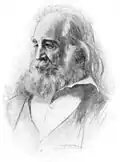There Was a Child Went Forth
"There Was a Child Went Forth" is a poem written by Walt Whitman and included in the 1855 edition of Leaves of Grass. In the 1856 edition, Whitman titled it, "Poem of the Child That Went Forth, and Always Goes Forth, Forever and Forever".[1] The poem was given its present title in the 1871 edition, and was included in the "Autumn Rivulets" cluster in the 1881 edition.[2][3]
The Poem
| THERE was a child went forth every day,
And the first object he look'd upon, that object he became, The early lilacs became part of this child, The field-sprouts of Fourth-month and Fifth-month became part of him, His own parents, he that had father'd him and she that had conceiv'd him in her womb and birth'd him, The mother at home quietly placing the dishes on the supper-table, |
The text of the poem suggests it is autobiographical with its vivid renderings of the impressions and experiences of a growing child.[6][7] The poet presents a mixture of country and city scenes as he records his memories of early domestic life and his perceptions of the world outside.[8] Although "There Was a Child Went Forth" was not one of Whitman's longer poems, he still employed his characteristic "catalogue technique" to build a sense of progression as he describes the changing of the seasons, and the child's expanding awareness and comprehension of his surroundings.[9][10]
Some critics have interpreted the poem not just as a metaphor of a child's journey from infancy to adulthood, but also as a metaphor of "the journey of young America from embryo to world power."[11]
In popular culture
- The poem has been set to music by Joel Puckett.[12]
References
- ^ Bradley, Sculley; Blodgett, Harold W., eds. (1973). Leaves of Grass. A Norton Critical Edition. New York: W. W. Norton & Co. p. 364.
- ^ "Cluster: Autumn Rivulets. (1891)". The Walt Whitman Archive. Retrieved 22 July 2017.
- ^ Aspiz, Harold (1966). "Educating the Kosmos: 'There Was a Child Went Forth'". American Quarterly. 18 (4): 655–666. doi:10.2307/2711388. ISSN 0003-0678. JSTOR 2711388.
- ^ "There Was a Child Went Forth". The Walt Whitman Archive. 1881 edition of the poem.
- ^ Bradley & Blodgett 1973, p. 364: Whitman initially appended the following last line to the poem: "And these become of him or her that peruses them now." The line was dropped in the 1867 Leaves of Grass edition.
- ^ Bradley & Blodgett 1973, p. 365.
- ^ Demirturk, E. Lale (Spring 1985). "Walt Whitman's 'There Was a Child Went Forth': The Image of 'Edges' in the Origins of Life" (PDF). Walt Whitman Quarterly Review. 2 (4): 41–45.
- ^ Slattery, Margaret Patrice (June 1969). "Patterns of Imagery in Whitman's 'There Was a Child Went Forth'". Walt Whitman Quarterly Review. 15 (2): 112–114.
- ^ "Catalogues". The Walt Whitman Archive. 1998.
- ^ Buell, Lawrence (2016) [1973]. "Catalogue Rhetoric". Literary Transcendentalism: Style and Vision in the American Renaissance. Cornell University Press. pp. 172–173. ISBN 978-1501707650 – via Project Muse.
- ^ Tian, Junwu (2019-10-02). "Metaphor of Child Journey and America Growth in Walt Whitman's "There Was a Child Went Forth"". ANQ: A Quarterly Journal of Short Articles, Notes and Reviews. 32 (4): 240–243. doi:10.1080/0895769X.2018.1543575. ISSN 0895-769X. S2CID 166191402.
- ^ "There Was a Child Went Forth: I. There Was a Child – song and lyrics by Joel Puckett". Spotify. December 19, 2023.
